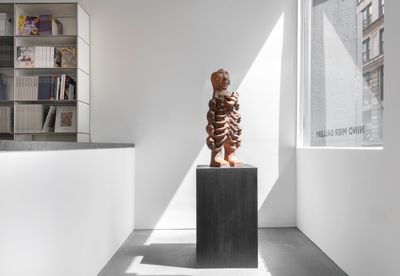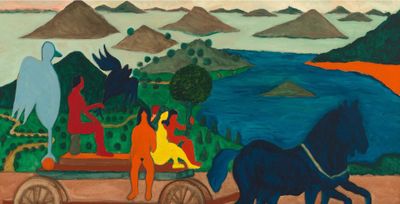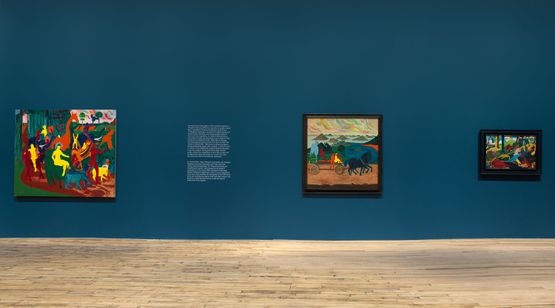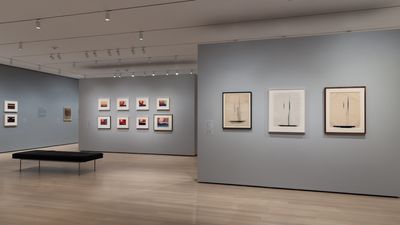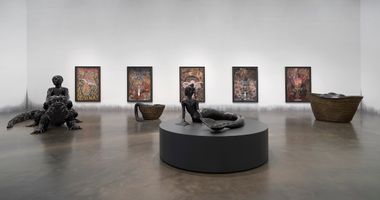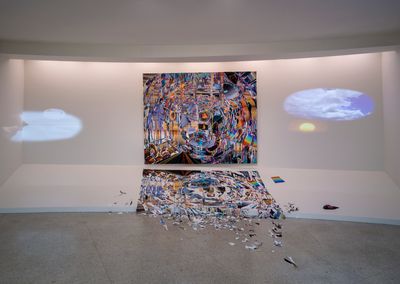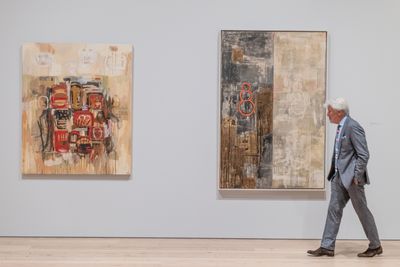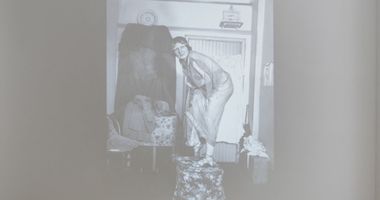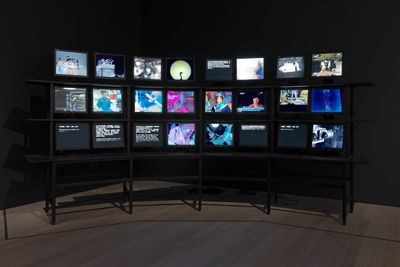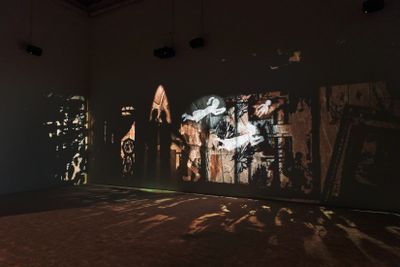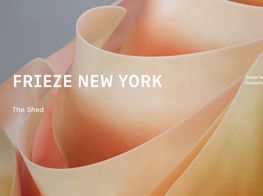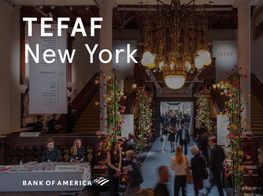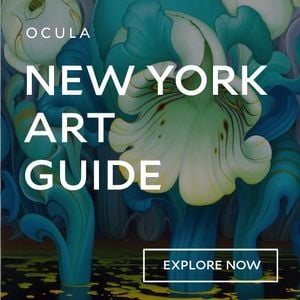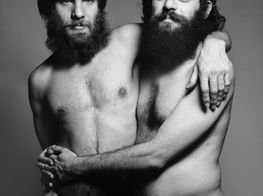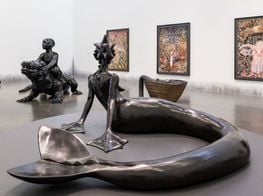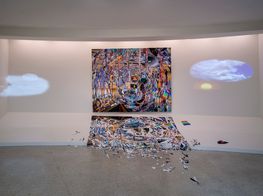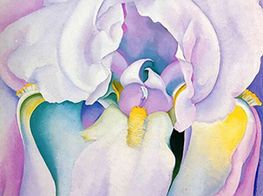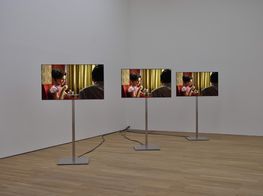New York Lowdown: Must-See Exhibitions Spring 2023
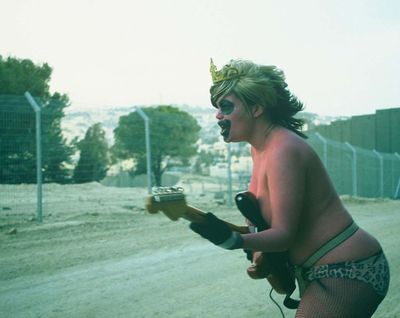
Tracey Rose, San Pedro V 'The Hope I hope' The Wall (2005) (detail). Giclée print. 84.91 x 63.46 cm. Courtesy the artist.
This spring, New York hosts some of the most anticipated retrospectives of the year including Wangechi Mutu's arresting sculptures at Whitney Museum of American Art and Sarah Sze's monumental installations gracing the Guggenheim.
Art fairs TEFAF New York (12–16 May) and Frieze New York (17–21 May) are a definite stop for serious collectors and, for everyone, Brooklyn's Live Ideas Festival 2023 (17–21 May). Ocula Magazine shares its must-see exhibitions across New York's galleries, institutions, and non-profit spaces.
GALLERIES
Seyni Awa Camara 1990–2022
Nino Mier Gallery, 62 Crosby Street
4 May–10 June 2023
Expect: galleries filled with imposing clay totems of a resonant burnt orange, often presenting hybrid figures touching on themes of nature, birth, and industrialisation.
Now in her 80s, Seyni Awa Camara was initiated to the potential of ceramics at a young age through utilitarian pottery that was made to be sold at the market in the village of Bignona, Senegal, where she continues to live and work today.
Camara's rugged totems appear to be retrieved from premonitions and dreams. Attached to a central body, animals and humans are stacked upon one another in sculptures such as Couple torse séparé base ronde (2009), which illustrates a traditional family scene.
At the top of the totem are a woman and a man. Both hold a child, as a succession of children trickle down the vertical sculpture, each gripping onto the central body, nodding to the simultaneous responsibility and burden of bringing an entity to life, in flesh or clay.
Beyond birth, nature and industry are another interest in Camara's work, as noted in ceramics that feature animals such as turtles, lizards, or kangaroos, in the case of Car with kancourang on the roof (c. 1995), on vehicle-shaped sculptures, suggesting the lingering presence and enduring importance of breathing beings in a machine-driven world.
Bob Thompson: So let us all be citizens
David Zwirner, 52 Walker Street
21 April–8 July 2023
Expect: bright, allegorical paintings that employ an intuitive visual language to democratise images in art history, while reflecting on America's political state.
Bob Thompson's jazz-inflected paintings speak to the tumultuous decades of the 1950s and 60s in America, largely marked by looming war and civil protest.
As other artists turned to abstraction during that time, Thompson's distinct figurative paintings featured bright, fauve-inspired accents that drew from the artist's love for music, appreciation for art history, and desire to democratise artistic expression.
These influences are noted in Garden of Music (1960), where a group of jazz musicians gather to play in a flat, dotted landscape, one figure an emotive pale green, another violet. Homage to Nina Simone (1965) pays tribute to the singer and activist with bold red hues and interrelated forms that preside over the gathering like a snaking rhythm.
Titled after a speech Thompson made, 'Building through Citizenship', So let us all be citizens recalls the democratic undertones of the painter's vision. The artist adapted paintings by old masters, including della Francesca, Massaccio, and Gauguin, into expressive compositions where primitive forms, bold hues, and urgent strokes articulate feelings and existences that can be grasped without art-historical knowledge.
A concurrent exhibition at David Zwirner, London, speaks to the painter's enduring influence. There, work by his contemporaries—notably, Studio Museum Harlem co-founder and abstract painter Betty Blayton and figurative painter Vivian Browne—are shown alongside that of subsequent generations Thompson influenced.
Avedon 100
Gagosian, 522 West 21st Street
4 May–24 June 2023
Expect: iconic and rare photographs by Richard Avedon hand-picked by some 150 artists, curators, designers, and public figures, including Elton John, Donatella Versace, Paloma Picasso, and Gagosian himself.
On the centenary of Richard Avedon's birth, Avedon 100 attests to the artist's six-decade-long influence, which not only revolutionised fashion photography, but enlivened classic portraiture and helped to cement photography as a contemporary art form.
With an impartial gaze, Avedon shot portraits of civil rights leaders such as Martin Luther King, Malcolm X, and Julian Bond, as well as American segregationist Alabama Governor George Wallace, everyday protestors, and soldiers from the Vietnam War.
Beyond larger-than-life figures, Avedon was known to capture fashion within the everyday, opting to shoot models outside the studio. He worked for Harper's Bazaar and The New Yorker, among other publications, and was among the first to photograph models of colour.
Emma Watson's pick, a 1965 portrait of Donyale Luna, the first Black model to illustrate Vogue's cover, pays tribute to Avedon's indiscriminate eye—the image generated controversy at the time, leading to the artist's resignation from Harper's Bazaar.
Hillary Clinton has chosen her 2003 portrait for The New Yorker. In the portrait, the seated politician is draped in a wholesome cardigan. She presents a heartfelt smile while holding light-framed glasses to her chest. Speaking of her early years at the White House, the caption reads: 'I made a lot of mistakes ... I learned from [them] ... At least, I hope ...'.
MUSEUMS AND NON-PROFIT SPACES
Georgia O'Keeffe: To See Takes Time
The Museum of Modern Art, 11 West 53rd Street
9 April–12 August 2023
Expect: a glimpse into the wide spectrum of materials and mediums used by the artist beyond her acclaimed flower paintings.
The first female artist to be surveyed at MoMA with a retrospective in 1946, O'Keeffe returns to MoMA with sinuous landscapes, atmospheric nudes, and abstract charcoals, dubbed the 'purest, finest, and sincerest things' by critics, spotlighting the artist's lesser-seen works on paper, which echo while offering another perspective into her paintings.
Despite O'Keeffe's initial education in the realist tradition, the artist's intuitive approach is well noted in her drawings, which trace nature's rhythmic variations with materials that imprint and leave a trace, capturing what she called the world's wonder and expansiveness.
Abstracted motifs such as spirals, recalling whirlpools, feature alongside atmospheric sunsets and seascapes, black-and-white portraits, and of course, flowers. The collection of work, rendered in soft blends of charcoal, pencil, watercolour, or pastel, rounds out viewers' expectations of what they can expect from the artist's practice.
Wangechi Mutu: Intertwined
New Museum, 235 Bowery New York
2 March–4 June 2023
Expect: arresting sculptures, hybrid collage-paintings, and a video illustrating Black imaginaries through a blend of Afrofuturism, mythology, and pop culture.
Wangechi Mutu's significant survey at New Museum fills the entirety of the seven-storey museum with more than 100 works that follow the artist's 30-year career touching on issues of identity, colonialism, feminism, and globalisation.
While trained as a sculptor, Mutu first gained recognition for her collage-paintings of anthropomorphic figures made from images of machines, human body parts, and nature cut from fashion, medical, and porn magazines.
'My obsession with the Black female body is a kind of obsession with myself navigating the world in a very sort of processed form,' the Nairobi and New York-based artist told Louisiana Channel in 2015.
Collage enables this process. In Intertwined (2003), two femmes with dog heads bite on a slice of meat. Mutu recontextualises her figures, here framed by cascading vines, from existing associations of gender and race, while speaking to our inherent connection to other beings and the earth.
'So many artists today are working with natural materials, cyborgian creatures, and themes Wangechi explored for decades,' curator Margot Norton tells Ocula Magazine in 2023.
Recent sculptures incorporate soil and materials from the Kenyan landscape, inspired by her return to Nairobi in 2015. Notable are the standing figures from the 'Sentinel' series, which appeared at the 2019 Whitney Biennial. Others, like the open-mouthed steel medium The Seated I (2019), nod towards possible futures.
Sarah Sze: Timelapse
Solomon R. Guggenheim Museum, 1071 5th Avenue
31 March–10 September 2023
Expect: multimedia, multi-sensory installations framing fragmented reflections on time and place, and the museum's role as guardian.
How do humans track time? How does time restrain them? Seeking answers, American visual artist Sarah Sze re-imagines the museum as a public timekeeper for Timelapse.
Sze has conceived a series of site-specific installations spanning sculpture, painting, installation, and sound that run through the Frank Lloyd Wright building and beyond the UNESCO-protected museum's walls into external public spaces.
Sze, a modernist adapting to a post-modern world, is known to use assemblage and sensory materials to create galactic-inspired formations that contemplate our place in the universe, with motifs such as the double helix and surfaces mirroring exploding glass fragments.
Sze's monumental accumulations of material have been compared to attempts to 'locate and dislocate oneself in time and space'. Timekeeper (2016), from the Guggenheim collection, is one such multi-sensory installation, with mirrors, projectors, stools, lamps, and prints arranged on a desk like an alchemical experiment.
On view is Sze's first sculpture to incorporate video, Untitled (Media Lab) (1998), with different scenes from daily life projected onto readymade objects—plants, lamps, ladders, tripods, fans. Beautiful but contemplative, they ask how we mark time and how time marks us.
Jaune Quick-to-See Smith: Memory Map
Whitney Museum of American Art, 99 Gansevoort Street
19 April–13 August 2023
Expect: a rare take on the American landscape, its society, culture, and politics through the eyes of a Native American painter who renders its every violence.
Memory Map is Jaune Quick-to-See Smith's first New York survey and most comprehensive exhibition to date. Five decades of work of over 130 paintings, sculptures, and prints contemplate the state of present-day America through the artist's Native American lens.
Of Métis and Shoshone descent, Smith, now 93 years old, became known in the 1970s for paintings and prints that adapt abstract and neo-Expressionist forms to address issues of cultural erasure, racial oppression, and environmental decay. With gripping visualisations, they cast attention on the historical marginalisation and present-day challenges facing Indigenous populations across North America.
Smith's earliest works intentionally deviated from traditional landscape conventions, marking human presence and movement across the land. Painted in personally significant places such as Wallowa, Oregon, and her reservation, they recall our emotional ties to land, which is often reduced to a resource from the perspective of politics and industry.
I See Red: Snowman (1992) responds to a key act of violent displacement: Christopher Columbus' arrival to the Americas in 1492. The event's 150th anniversary celebrations in the United States inspired Smith to organise anti-celebrations, exhibitions, and adopt the medium of collage and motifs such as bison and trade canoes.
Over three metres tall, the mixed-media collage layers a row of posters branding the Native American identity as serving the local 'community' overseen by red strokes covering comic panels and strips of text. One reads 'Nothing like a little demonstration to get people involved.'
Iiu Susiraja: A style called a dead fish
MoMA PS1, 22-25 Jackson Avenue, Queens
20 April–4 September 2023
Expect: absurd, sincere, and almost-surreal photographs and videos by a seemingly detached artist who presents deadpan still lifes using bright props and her own body.
Iiu Susiraja's self-portraits are nothing less than stunning. Since 2008, the artist has made her 145-kilogram body the centrepiece of her work, resulting in dead-pan portraitures that are compelling in their sincerity, provocation, and absurdity.
Shot inside her apartment in Turku, Finland, the artist stages her silhouette against fluorescent studio backdrops and ornate wallpapers, framed by whimsical props such as umbrellas, bananas, sausage, rubber ducks, and dead fish that contrast her banal surroundings.
In Fountain (2021), the artist appears partially nude, spread open on the bed. Her face is hunched in one corner of the room, while a translucent umbrella filled with rubber ducks stands upright over her genitals.
Susiraja notes, 'I don't actually do much consciously ... Other than list objects on paper and go and fetch them.' The images recall the conditions of working in a post-medium world where objects and materials are essentially stripped of meaning through their constant repurposing and redefinition—something that perhaps started with Duchamp's Fountain (1917).
The artist's underhanded approach makes for a rare impartial gaze. Unclothed inside a kitchen with a heart-shaped balloon over her figure in Happy Valentines Day (Big Heart) (2022), the female nude is stripped of its emotional charge as we note the artist's neutral expression.
Signals: How Video Transformed the World
The Museum of Modern Art, F6, 11 West 53 Street
5 March–8 July 2023
Expect: a tracing of the rise and prominence of video over six decades, reflected in more than 70 media works from MoMA's collection, including work by Sondra Perry, Ming Wong, and Stan VanDerBeek.
Since the inception of time-based media, artists have used video as a medium to pose urgent questions about society and present new forms of public life.
This trajectory is documented at MoMA in the work of video-art pioneers such as Nam June Paik who introduced new experimental forms at the medium's onset, and Gretchen Bender who confronted the consequences of digital media and technological acceleration in the 1980s.
Others such as John Akomfrah—a member of the Black Audio Film Collective and a video artist who centres postcolonial and diasporic experiences—turn to moving images not only to illustrate history and its bearing on the present, but to establish networks of solidarity.
Akomfrah's Handsworth Songs (1986) documents the hopes and dreams of Black British populations amid the 1965 riots in Birmingham and London, responding to the over-policing of Black communities while contending with Britain's colonial past and ongoing racial and class tensions.
Speaking to the relevance of film in sharing minority experiences, Martine Syms' The African Desperate (2022), which premiered at MoMA's New Directors/New Films festival in 2022, recounts the artist's experience as an MFA student in establishments that are often white and male-led, and the misunderstandings and frustrations that ensued.****
Lap-See Lam: Tales of the Altersea
Swiss Institute, 38 St. Marks Place
10 May–27 August 2023
Expect: a room-spanning video and CGI installation centring on the story of an abandoned Chinese restaurant inside a three-storey ship that once sailed from Shanghai to Europe.
Calling on her Swedish and Cantonese heritage, Lap-See Lam explores notions of identity and culture through the experiences of the Chinese diaspora in Sweden. The artist's first solo exhibition in the United States begins with her 3D documentation of the interiors of abandoned Chinese restaurants in the 2010s, including her family's own establishment.
Resulting works such as Mother Tongue (2018) feature three generations of women discussing their working experiences in such restaurants, while Phantom Banquet (2019), commissioned by Performa 19, borrows from hospitality traditions of Swedish-Chinese restaurants to examine how environments can shape identity.
The titular work Tales of the Altersea (2023) continues Lam's inquiry into Chinoiserie in Sweden and Europe, more broadly. The eight-screen video installation centres on the story of Sea Palace, a now-abandoned restaurant ship that sailed from Shanghai to Europe in the 1990s.
Bankrupt after one year, the dining establishment was later reconfigured into a haunted house for children in Stockholm. Its trajectory mirrors the appeal of Sinophone culture and traditions to outsiders and the corresponding erasure and disappearance within its diasporas.
The exhibition features public programmes and events in New York and Frankfurt, where an iteration of the exhibition is being presented simultaneously at Portikus, including a culinary event and a synchronised concert, connecting the two trade centres and suggesting art can perhaps offer a way forward when traditional categories rupture.
Tracey Rose: Shooting Down Babylon
Queens Museum, New York City Building, Flushing Meadows Corona Park
23 April–10 September 2023
Expect: three decades of radical performances by an unapologetic artist who expresses tensions and biases toward Black people and women using her body.
Organised by Zeitz Museum of Contemporary Art Africa, Cape Town, Shooting Down Babylon gathers Tracey Rose's work since the 1990s, which has continuously explored post-colonial conditions and their limitations on identity and cultural discourse.
In Rose's work, the body is a site of resistance, discourse, and healing. Subverting traditional gender and racial representation with calculated violence, the artist conceives absurd and anarchic imagery, with the body stripped down at times and over-embellished at others.
Early works such as the 1998 Ongetiteld (Untitled) show the artist shaving her entire body, the act recorded with surveillance cameras. 'The piece is about making myself unattractive and unappealing,' Rose says. Noting she then became attractive to a different group, she adds, 'perhaps there was not enough of a sense of penance and flagellation in the work.'
Ciao Bella (2001), which was presented by the artist for the South African Pavilion at the Venice Biennale in 2001, features photographs of Rose dressed as archetypes of female beauty such as Nabokov's Lolita, the porn star La Cicciolina, and a nun, alongside a video parody of Jesus' last supper.
In the video, the artist plays a host of characters sitting around a banquet table, including a mermaid, a dominatrix, and Marie-Antoinette. The majority die at the hands of a shot-gun-wielding bunny in the end, recalling absurd social conditions within the lives of many, where survival is premised on the performance of pre-existing roles. —[O]

